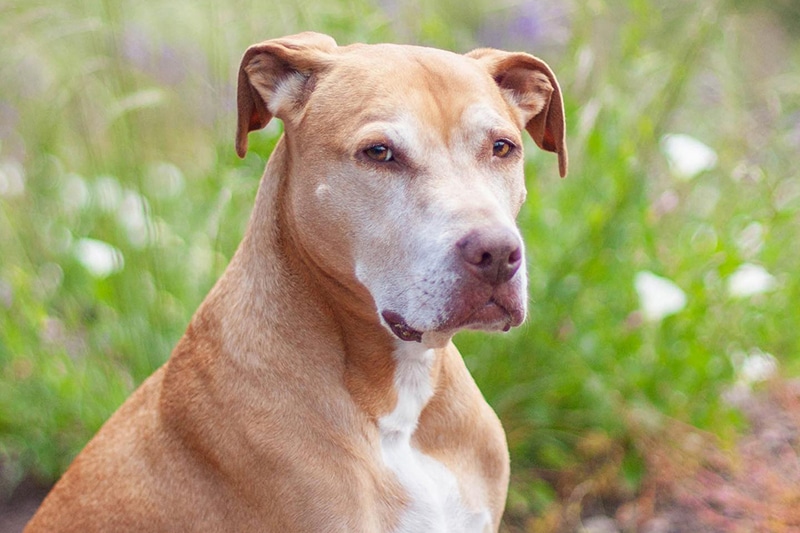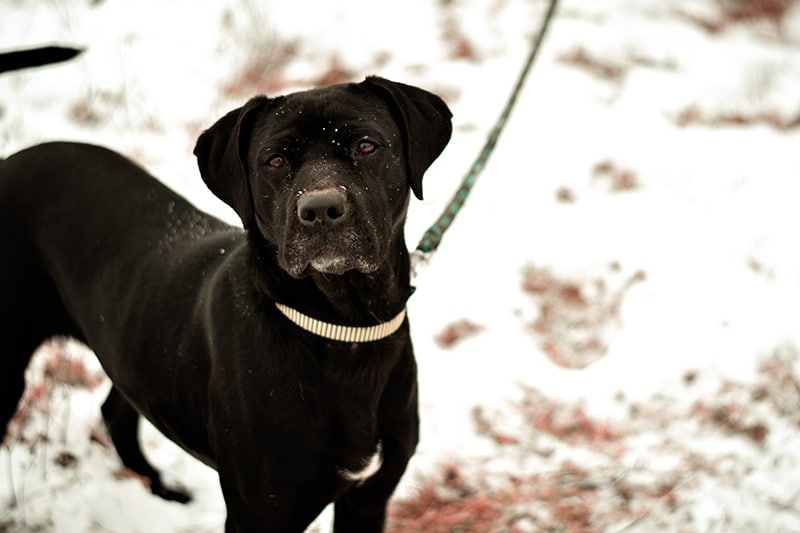The Rhodesian Ridgeback Pitbull mix is a medium-sized mixed-breed dog that pairs the intimidating guard dog, the Rhodesian Ridgeback, with the lovable and sometimes mischievous American Pitbull Terrier. The Ridgeback Pitbull mix is sure to be a handful for those who aren’t good with strong, athletic dogs, but a fantastic option for those looking for a companion pet for their active family unit.
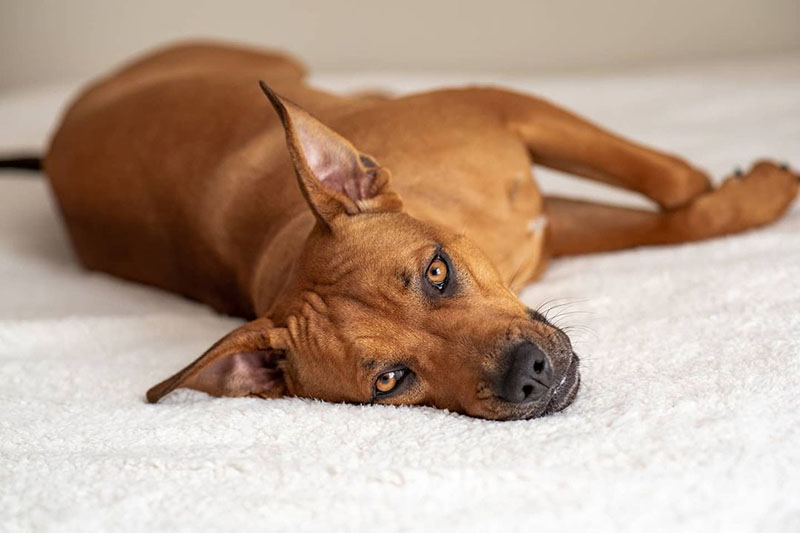
Like both parent breeds, the Rhodesian Ridgeback Pitbull mix will have high energy levels and may be physically intimidating to strangers and other dogs. The Rhodesian Ridgeback makes an excellent guard dog in its own right, so your Rhodesian Pit will be an excellent companion for those with children.
To learn about this relatively new mixed-breed dog, we’ll explore the history, temperaments, and popularity of the Rhodesian Ridgeback and Pitbull. By the end of this guide, you’ll know the Rhodesian Ridgeback Pitbull is the right mixed-breed for you.
Pitbull Rhodesian Ridgeback Mix – At a Glance
| Weight: | 75 – 85 pounds |
| Height: | 25 – 27 inches |
| Lifespan: | 10 – 16 years |
| Coat Colors: | Wheaten, black, red, buckskin, brindle |
| Temperament: | Active, energetic, loyal, loving, reserved |
| Most Suitable For: | Active families with or without children, active single individuals |
What Does a Pitbull Rhodesian Ridgeback Mix Look Like?
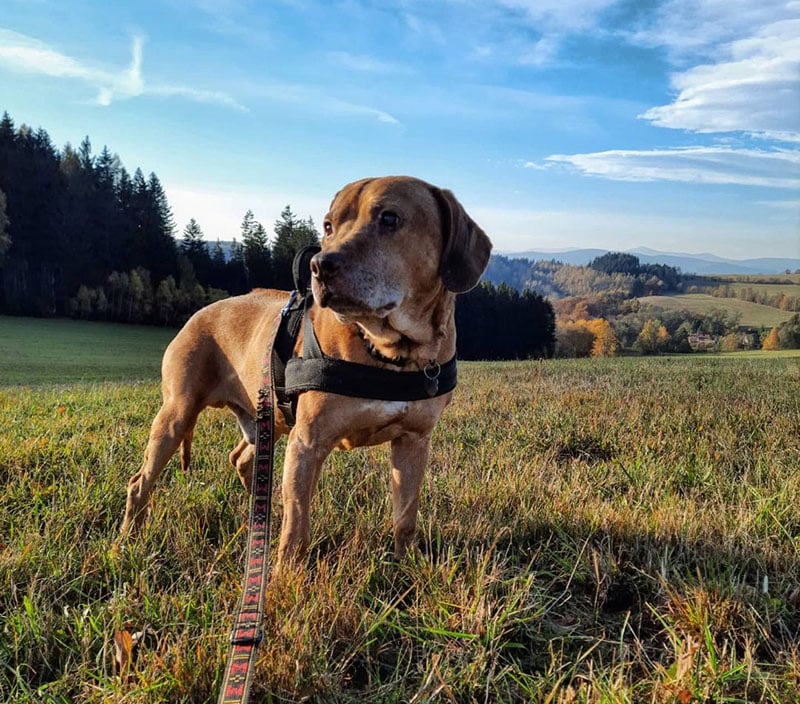
The Pitbull Rhodesian Ridgeback mix will follow in the footsteps of all designer dogs and borrow different parts of its physical appearance from both parent breeds. Rhodesian Ridgebacks tend to be taller than Pitbulls and have longer bodies. You can expect your Pitbull Rhodesian Ridgeback mix to be perhaps longer in the body than a traditional Pitbull, but maintain the stout, broad-chested, muscular body type of the Pitbull.
Your Rhodesian Pitbull may also inherit the signature Ridge ears – which are generally larger than their head and fold forward. They may also inherit the upright ears of the Pitbull, or forward-growing hair – most dogs hair grows in all different directions.
When it comes to coat grooming, you won’t have to worry too much as the Pitbull Ridgeback will likely have a short-haired coat type, that isn’t a double coat. Their coat colors can vary, but expect a glossy coat finish.
Are you looking for a way to treat your furry friend? Sign up for our newsletter for a chance to win a free month of Barkbox!
The History of the Pitbull Rhodesian Ridgeback Mix
When it comes to the Pitbull Ridgeback, there isn’t a whole lot of history to go off. It is commonly thought that this designer breed came about during the 1990s and early 2000s, when crossbreeding was popular throughout the United States.
To learn more about the Ridgeback Pitbull, we’ll explore the history of their parent breeds.
The History of the Rhodesian Ridgeback

The Rhodesian Ridgeback’s history stretches back centuries, specifically beginning in the mid-19th century, when the Khoikhoi People began trading with Dutch settlers in the region. Back then, the Rhodesian Ridgebacks could be found all over Southern Africa, but most were indigenous to South Africa, as this was largely where the Dutch concentrated their trading efforts.
Dutch settlers of the day noted a semi-domesticated hunting breed used by the Indigenous peoples, bearing striking similarities with what we now know to be the Rhodesian Ridgeback in its indigenous form. The dog had a strong prey drive, with a distinctive ridge in it’s back (hence the name).
As the 20th century came around, Rhodesian Ridgebacks were imported to Europe and crossbreeding began soon thereafter. Various dogs were used, including: Greyhounds, Mastiffs, Wolfhounds, Great Danes, and Bloodhounds.
It wasn’t until 1922 when the original breed standard was drafted that the first Rhodesian Ridgeback Club was founded in Rhodesia – now modern-day Southern Africa, including South Africa. In the early 1950s, six Rhodesian Ridgebacks were brought to the United States from Britain and it wasn’t long before the breed was recognized by the American Kennel Club in 1955.
Ridgebacks were mostly used as guard dogs or working dogs on farms in the mid-West and still maintain such working dog status today, although they are more commonly family pets.
How Popular Are Rhodesian Ridgebacks in the United States?
The Rhodesian Ridgeback was first brought to the United States in 1952, and since then, it has gained steady popularity as a guard dog, working farm dog, and companion pet.
Despite only being recognized by the American Kennel Club in 1955, this powerful breed ranks highly in the popularity rankings. In 2021, the Rhodesian Ridgeback was the 51st most-popular dog in the United States.
Who Are Rhodesian Ridgebacks a Good Dog For?
Given their size, agility and exercise requirements, the Rhodesian Ridgeback certainly isn’t a dog for everyone. They’re a large-size dog, typically reach between 25 and 28 inches tall, and their long, slender bodies mean they’re far better-suited for a house with a yard.
Rhodesians require lots of exercise and are often quite stubborn, thus requiring an experienced owner who knows how to take command of such a dog.
How Did Rhodesian Ridgeback Come About?
Their pre-colonial origins in Southern Africa are unknown. However, they were first noted by Dutch settlers in the 18th century, who, as the 19th century dawned, imported the first Rhodesian Ridgebacks to Europe and bred them with other hunting dogs, such as the Great Dane, Bloodhounds, Wolfhounds, Greyhounds, and Mastiffs.
Breed experts believe that this crossbreeding resulted in the Rhodesian retaining only 4% of its pre-colonial genetic makeup.
When Did We First Cross-Breed The Rhodesian Ridgeback?
The first crossbreeding of the Rhodesian Ridgeback occurred during the 19th century when they were imported to Europe and crossed with various European hunting dogs.
Modern-day crossbreeding of the Rhodesian Ridgeback likely occurred during the 1990s and early 2000s, as crossbreeding gained popularity in the United States.
Popular Rhodesian Ridgeback mixes include:
- Rhodesian Ridgeback Labrador Mix (Rhodesian Lab)
- Rhodesian Ridgeback German Shepherd Mix (Rhodesian Shepherd)
- Rhodesian Boxer Mix (Rhodesian Boxer)
- Rhodesian Ridgeback Husky Mix (Ridgebacksky)
- Rhodesian Ridgeback Rottweiler Mix (Ridgeback Rottie)
The History of the Pitbull
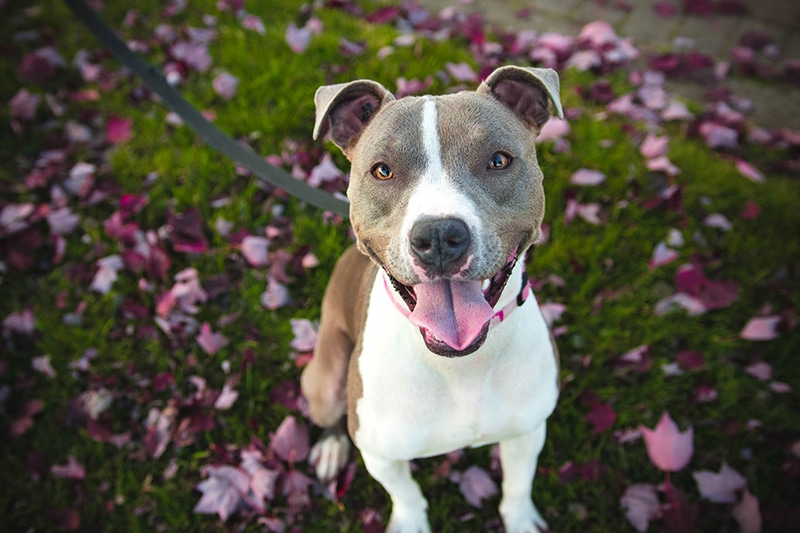
Unlike the Rhodesian’s relatively tame history, the Pitbull’s is one of blood sports, anguish, and challenges. Bred from the English Bulldog and the “black and tan terrier”, the Pitbull is a medium-sized, muscular breed of dog with a broad chest and a goofy smile!
The Pitbull was originally bred for blood sport in England in the late 18th and early 19th centuries. Bred for a sport known as ‘bull-baiting,’ wherein a dog, such as a Pitbull, Boxer, or another type of fast, muscular terrier, would be placed into a pen with an angry bull cow and made to run. The ‘sport’ would continue until either the dog was killed or the cow collapsed from exhaustion.
This blood sport continued in the UK until 1835, when the Cruelty to Animals Act was made law, which outlawed the ‘sport’ altogether. The Pitbull migrated to being used as a fighting dog in underground (illegal) dog fighting rings for much of the rest of the century.
It wasn’t until the late 19th and early 20th centuries when the practice of using dogs for blood sport began to wane, and dogs became more companion/family pets rather than solely utilitarian. The Pitbull was brought to the United States in the mid-19th century and unfortunately retained some of their dogfighting history, until that practice was also outlawed and popularity waned.
The American Pit Bull Terrier was recognized by the United Kennel Club as a singular breed type in 1898. However, the larger organization, the American Kennel Club, did not recognize the American Pitbull Terrier and has still yet to do so.
How Popular Are Pitbulls in the United States?
Pitbulls were first brought to the United States between 1845 and 1860, fast becoming popular sporting dogs. It wasn’t until before the Second World War that Pitbulls began to be used in other contexts such as police and military work, therapy dogs and faithful family pets.
Unfortunately, the American Pit Bull Terrier isn’t an AKC-recognized breed and thus, no popularity statistics from the AKC are available. However, the United Kennel Club did recognize the Pitbull as an actual breed – however, they do not keep popularity statistics.
Our best information is that Pitbulls make up almost 20% of America’s ‘strong dog’ population.
Who Are Pitbulls a Good Dog For?
Given their size and strength, as well as their stocky, muscular bodies, Pitbulls are best-suited for experienced owners with the physical capacity to handle them. They’re not well-suited for novice dog owners and need an active owner to give them the hours of exercise they’ll need each week!
Pitbulls fare much better with a house and yard than with apartment living. Pitbulls generally require plenty of physical exercises and mental stimulation to lead healthy lives.
How Did Pitbulls Come About?
Pitbulls were originally bred from the Old English Bulldog and the black-and-tan terriers, sometime in the early 19th century. Originally used as ‘bull-baiting’ dogs, Pitbulls eventually became popular companion pets once the practiced was outlawed as illegal practicing of ‘bull-baiting’ and dog fighting waned at the end of the Second World War.
When Did We First Cross-Breed The Pitbull?
The Pitbull is one of the world’s most popular crossbreeding dogs! This is largely because Pitbulls occupy a grey area in legal ownership. There are some countries where ownership of Pitbulls is banned outright (France, for example), but some countries (like the United States) don’t have outright bans. Still, a number of U.S. states have restrictions surrounding ownership of purebred Pitbulls.
As a way to circumvent these restrictions, Pitbulls are a very popular crossbreed and became much more popular in the 1990s and early 2000s, as the practice of crossbreeding accelerated throughout the United States.
Some popular Pitbull crossbreeds include:
- Pitbull Shih Tzu Mix (Pit Shih)
- Pitbull Doberman Mix (Doberman Pit)
- Pitbull Catahoula Mix (Pitahoula)
- Pitbull Greyhound Mix (Grey Pit)
- Pitbull Yorkie Mix (Yorkie Pit)
How Important Is a Dog’s Temperament to Your Family?
When you start to think about getting a dog, one of the most important parts of the process is the research you do beforehand. From equipment you’ll need to breed considerations, there’s a lot to look up!
One of the most important things is researching different breed temperaments, to see if that particular breed is a good fit for your family. Essentially, you’ll want to make sure that you won’t need to pour time and money and training into a dog that’s just not what you’re looking for and doesn’t fit within your family unit.
For example, if you live in a small apartment building, your Great Dane isn’t going to be very happy without having the space it needs to maintain a happy life, or the exercise requirements it needs. Likewise, you won’t be trotting your Jack Russell Terrier up a mountain with you every weekend – they’re just not built for it.
Consider seriously what your habits and temperament are as a family, and then select a dog that you think best matches that. Adequate research will save you time, energy, effort, money, heartbreak, and possibly re-traumatizing your new dog if you’re forced to return it to where it came from.
What is the Temperament of the Pitbull Rhodesian Ridgeback Mix?
The Ridgeback Pitbull is an active dog breed requiring plenty of exercise. They are family dogs through and through and will likely inherit their Rhodesian work ethic, so they would do well as farm dogs. You can expect your Ridgeback Pitbull to be a loving and loyal dog with a guardian-type mentality and plenty of ‘stranger danger’ standoffishness toward those it doesn’t know.
Your Ridgeback Pitbull will likely be good with children and other pets, though beware of the Ridgeback’s prey drive if you have smaller pets that are traditionally a dog’s prey. Consistent training and positive reinforcement are key if you notice problems in this regard.
Is The Pitbull Rhodesian Ridgeback Mix Friendly?
In general, you can expect your Ridgeback Pitbull to be a very friendly animal with those it knows, and have a healthy suspicion of those it doesn’t!
Is The Pitbull Rhodesian Ridgeback Mix Easy to Train?
You might initially experience difficulty training your Ridgeback Pitbull mix, as they can be stubborn and independent animals. However, with time and a proper training regimen, your Ridgeback Pitbull will be following your lead in no time.
How Much Can A Pitbull Rhodesian Ridgeback Mix Weigh?
The average weight of a Pitbull Ridgeback mix is between 75 and 85 pounds.
How Tall Can A Pitbull Rhodesian Ridgeback Mix Get?
The average height of Ridgeback Pitbull mix is between 25 and 27 inches tall.
Similar-Sized Breeds
There are a few similar-sized breeds to the Pitbull Rhodesian Ridgeback mix. These include:
- Standard Poodle
- Rottweiler
- German Shepherd
- Labrador Retriever
Does the Pitbull Rhodesian Ridgeback Mix Shed?
You can expect your Pitbull Rhodesian Ridgeback mix to shed lightly throughout the year, but a weekly brush is always a good idea to mitigate shedding that does occur.
How Much Exercise Does A Pitbull Rhodesian Ridgeback Mix Require?
The Ridgeback Pitbull is an incredibly active breed – requiring at least 45 minutes to an hour of daily exercise.
How Long Can a Pitbull Rhodesian Ridgeback Mix Live?
The average life expectancy of a Ridgeback Pitbull is between 10 and 16 years.
What Health Conditions Could the Pitbull Rhodesian Ridgeback Mix Have?
- Hip Dysplasia (Hip joint inflammation)
- Elbow Dysplasia (Elbow joint inflammation)
- Dermoid Sinuses (Genetic skin condition)
- Mast Cell Tumors (Skin condition)
How Can You Find a Pitbull Rhodesian Ridgeback Mix Puppy For Sale?
Before you start your search for a Ridgeback Pitbull mix puppy for sale, you should strongly consider adoption as an option to acquire one of these puppy mixes. Adoptions are commonly an alternative to buying through a breeder.
Check your local vet clinic and animal shelter to see if anyone has put up a Ridgeback Pitbull mix for adoption.
Alternatively, you can check out AdoptAPet.com to see if anyone has posted a Ridgeback Pitbull mix for adoption online.
How Much Does a Pitbull Rhodesian Ridgeback Mix Puppy Cost?
The average price of a Ridgeback Pitbull mix puppy is around $1500! The cost of buying a Ridgeback Pitbull mix alone is enough of a reason to consider adoption!
However, if you’re looking to buy this mixed-breed dog, you can look for a reputable breeder online or by talking with local vets about reputable breeders in your area.
During your research, take some time to read our guide to working with a reputable breeder and avoiding puppy mills!
Is the Pitbull Rhodesian Ridgeback Mix the Right Breed For You?
If you’ve been looking for an active, guardian-type dog with a loyal and loving personality, then the Pitbull Rhodesian Ridgeback might be your best choice for a mixed-breed dog!
Consider reading our other breed guides for those who know that the Pitbull Rhodesian Ridgeback isn’t for them.

